
Moparts Tech Archive
Big Block
516 vs 906 test by fast68plymouth
BB heads...906 vs. 516fast68plymouth
Moparts Member
Posts: 3321
From: so burlington,vt usa
Registered: Aug 2000
posted 11-09-2002 08:21 PM
--------------------------------------------------------------------------------
first of all, id like to thank Chuck Best of Best Machine for donating the 516
and 906 heads for this little series of tests.
i also have a 915 on its way, but i figured id get started on these two before i get burried with
work.
i'll be performing all the work on these two heads at the same time, and using
all the same tooling for the work to the head, and the same valves for testing, with the
exception of the first test of the 516 exhaust port, which uses a smaller valve than
the 906(1.60 vs 1.74).
this first test is between the two heads with OE valves, no back cut, and the OE valve job.
906:
lift----in/ex
.100--60.8/49.6
.200-126.4/95.3
.300-186.7/130.0
.350-209.9/140.6
.400-222.7/147.9
.450-230.7/151.5
.500-233.9/155.2
.550-237.1/157.6
.600-235.5/157.6
.650-232.3/157.6
the first thing you should notice on this port is the drop in flow after .600 lift.
what this is basically saying is, the short turn can manage about 237cfm
before going turbulent. what will likely happen in the next step, which is a competition
style valve job with back cut valves, is that it will reach about 237cfm at a
slightly lower lift...and then still go turbulent.
contrary to the MP engine manual which says dont touch the short turn, if the short turn
doesnt get reworked, the flow wont ever really get much higher than what we have here.
this is more true for the 906 and 915 castings with the taller short turn.
here is the stock 516:
lift----in/ex
.100--62.3/46.5
.200-126.4/96.7
.300-177.0/120.9
.350-192.2/128.5
.400-198.6/133.4
.450-203.5/135.8
.500-209.9/138.2
.550-216.3/138.2
.600-219.5/139.4
.650-222.7/140.6
as you can see, the flow between the two heads in stock trim is quite a bit different.
its obvious why the 906 was the much more sought after head of the two.
we'll see how they both respond to some basic reworking.
===========================================
dennis3866
Moparts Member
Posts: 840
From: Boulder County, CO
Registered: Jul 2000
posted 11-09-2002 08:31 PM
Its interesting that the flow keeps climbing with more lift on the 516's, long after the 906 has saturated.
That suggests to me that valve shrouding in the combustion chamber might be an issue here. Are you planning to modify the combustion chambers?
==========================================
JohnRR
Moderator
Posts: 10382
From: Ma.
Registered: Nov 1999
posted 11-10-2002 11:12 AM
the 906 flow stock is a little better than i thought on the intake side considering how ugly it is as cast , the exhaust needs alot of work it seems .
as far as cutting on your own , a novice would be better off starting with stones till they get the feel of whats going on when you get inside a port , especially near the seats . and an angle grinder is really not suited for this type operation .
=========================================
fast68plymouth
Moparts Member
Posts: 3321
From: so burlington,vt usa
Registered: Aug 2000
posted 11-10-2002 02:07 PM
dennis, i hadnt planned on doing any real chamber "mods" to either of these heads, but its been a while since i did anything to a 516 head.
after looking at the chamber of the 516, i can see that for the head to become more effective in the mid-lifts, some serious unshrouding will need to be done.
i'll have to CC the chamber before i modify it, and then when im done to see how much of a gain in CR the 516 would give you over an open chambered head after the chambers have been reworked.
also, it appears that the intake bowls are "filled in" around the guide boss and the backside of the bowl compared to the 906. more material will likely have to be removed before the "big numbers" start showing themselves.
John, the 906 flow is on the high side for a stock head, but i have seen them in that mid-230's range before. the casting texture on this head is quite smooth, and the short turn has a slightly more gentle radius than some ive fooled with.
once the port starts getting reworked a little, the minor differences between a good one and a bad one diminish rapidly.
the one variable you can encounter with any head, which can lead to differences in flow form head to head, or even port to port is core shift.
this 516 head has a pretty bad case of it, and the 906 has almost none.
since the seats arent machined in the proper proximity to the port when the head has core shift, it will usually enhance the flow on the two ports where the shift creates some favorable bias, and hurt the flow on the two where the bias is unfavorable.
for this reason, i am going to do a right and left port on the 516 head to see how the core shift can affect the mirror imaged ports.
core shift is usually present to some degree in any head. the shift on this 516 head is pretty bad, and if this were a head that was slated for some serious porting, and going on a motor that was supposed to make big power....id be looking for another head to replace it.
==========================================
a few misc head results and pics
fast68plymouth
Moparts Member
Posts: 3604
From: so burlington,vt usa
Registered: Aug 2000
after i did the 346 vs 906 vs 516 comparo, i decided to fully port one cyl on each head, and see how they compared in a time vs flow test.
they all got the 2.14 valve. the 906 and 516 took the most amount of time because each just needs to have more metal removed from it.
in ascending order in terms of flow...here are the numbers. pics will follow as i get them uploaded.
516 head:
.100--69.0
.200-144.6
.300-208.5
.400-248.3
.500-264.3
.550-272.3
.600-277.1
.650-278.7
not bad numbers...but i have about 2hrs(or maybe a bit more) in this one intake port.
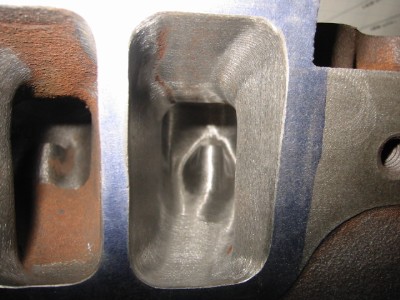
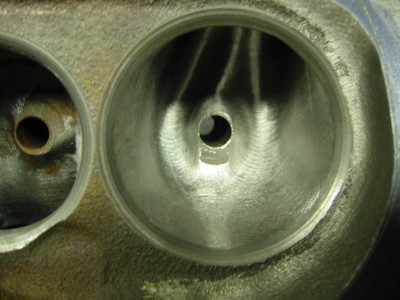
906:
.100--69.5
.200-148.2
.300-218.2
.400-262.7
.500-275.5
.550-285.2
.600-287.1
.650-288.8
.700-293.8
better numbers for sure, and about the same amount of time...roughly two hours in this intake port.
i feel there is still a little left in this port with some more short turn work. i have pretty much removed the entire guide boss, which on a 906 head, is a pretty big chunk of iron to grind out of a port.
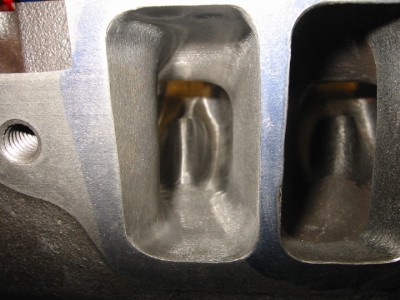
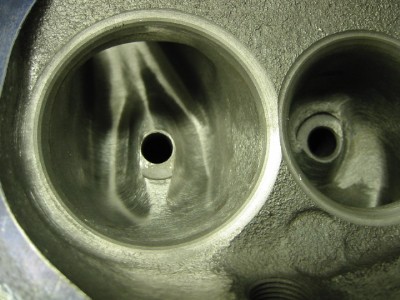
346:
.100--70.0
.200-148.2
.300-210.9
.400-243.5
.500-270.7
.550-278.7
.600-292.1
.650-298.9
.700-305.6
.750-308.9
this was about 1 hr 45mins worth of work. since the guide boss is much smaller to begin with, your porting efforts go farther with these heads. also, getting the short turn to work at high lifts is much easier than a 906 type head.
if you have to run OE iron, and want to run a high lift cam...these heads are easier to get big numbers from.
however, the taller short turn of the 906 does provide superior mid lift numbers.
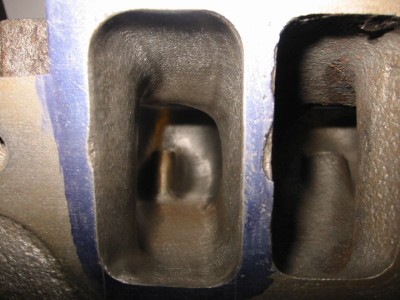

as you can see in this last pic, the 346 intake port was heavily biased, which i have found is one of the keys to getting the "big" numbers from these heads at high lift. its easier to get this type of shape into the 346/902/452 heads than the other castings.
as for the 516 results.....maybe 275+ isnt that bad....but it takes less than 1/2 that amount of porting to get that kind of number from a 346/452 type head.
plus...the 516 has some oddly shaped, and weak flowing exhaust ports.
=====================================

Tech Index